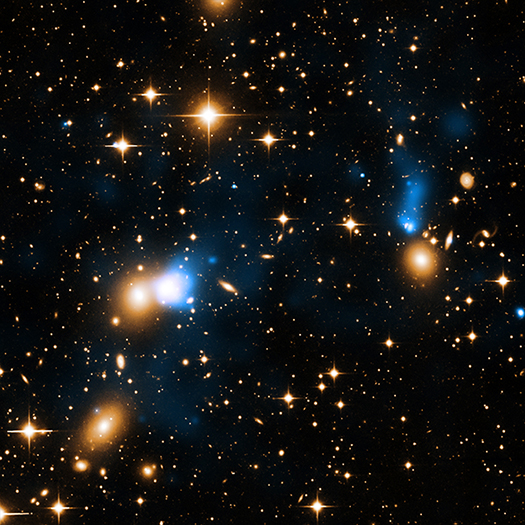Chandra Finds Remarkable Galactic Ribbon Unfurled

An extraordinary ribbon of hot gas trailing behind a galaxy like a tail has been discovered using data from NASA's Chandra X-ray Observatory, as described in our latest press release. This ribbon, or X-ray tail, is likely due to gas stripped from the galaxy as it moves through a vast cloud of hot intergalactic gas. With a length of at least 250,000 light years, it is likely the largest such tail ever detected. In this new composite image, X-rays from Chandra (blue) have been combined with data in visible light from the Isaac Newton Group of Telescopes (yellow) in the Canary Islands, Spain.
The tail is located in the galaxy cluster Zwicky 8338, which is almost 700 million light years from Earth. The length of the tail is more than twice the diameter of the entire Milky Way galaxy. The tail contains gas at temperatures of about ten million degrees, about twenty million degrees cooler than the intergalactic gas, but still hot enough to glow brightly in X-rays that Chandra can detect.
The researchers think the tail was created as a galaxy known as CGCG254-021, or perhaps a group of galaxies dominated by this large galaxy, plowed through the hot gas in Zwicky 8338. The pressure exerted by this rapid motion caused gas to be stripped away from the galaxy.
In images from Chandra and the NSF's Karl Jansky Very Large Array (not shown in composite), the galaxy CGCG254-021 appears to be moving towards the bottom of the image with the tail following behind. There is a significant gap between the X-ray tail and the galaxy, the largest ever seen. The significant separation between the galaxy and the tail might be evidence that the gas has been completely stripped off the galaxy.
Astronomers were also able to learn more about the interactions of the system by carefully examining the properties of the galaxy and its tail. The tail has a brighter spot, referred to as its "head". Behind this head is the tail of diffuse X-ray emission. The gas in the head may be cooler and richer in elements heavier than helium than the rest of the tail. In front of the head there are hints of a bow shock, similar to a shock wave formed by a supersonic plane and in front of the bow shock is the galaxy CGCG254-021.
More information at http://chandra.si.edu/photo/2015/z8338/index.html
-Megan Watzke, CXC
Please note this is a moderated blog. No pornography, spam, profanity or discriminatory remarks are allowed. No personal attacks are allowed. Users should stay on topic to keep it relevant for the readers.
Read the privacy statement
